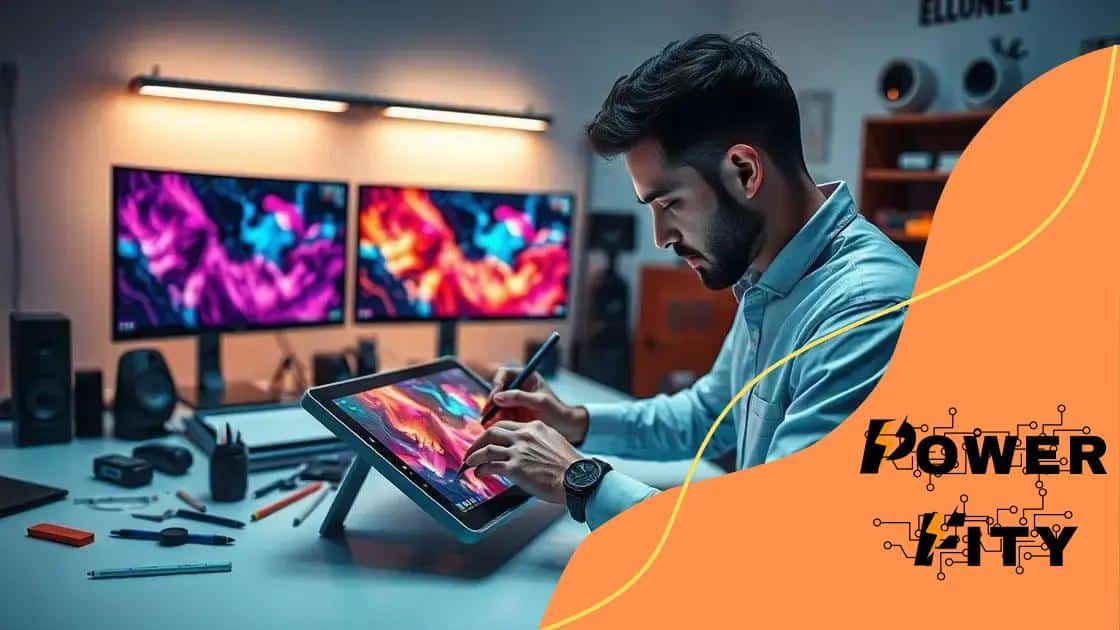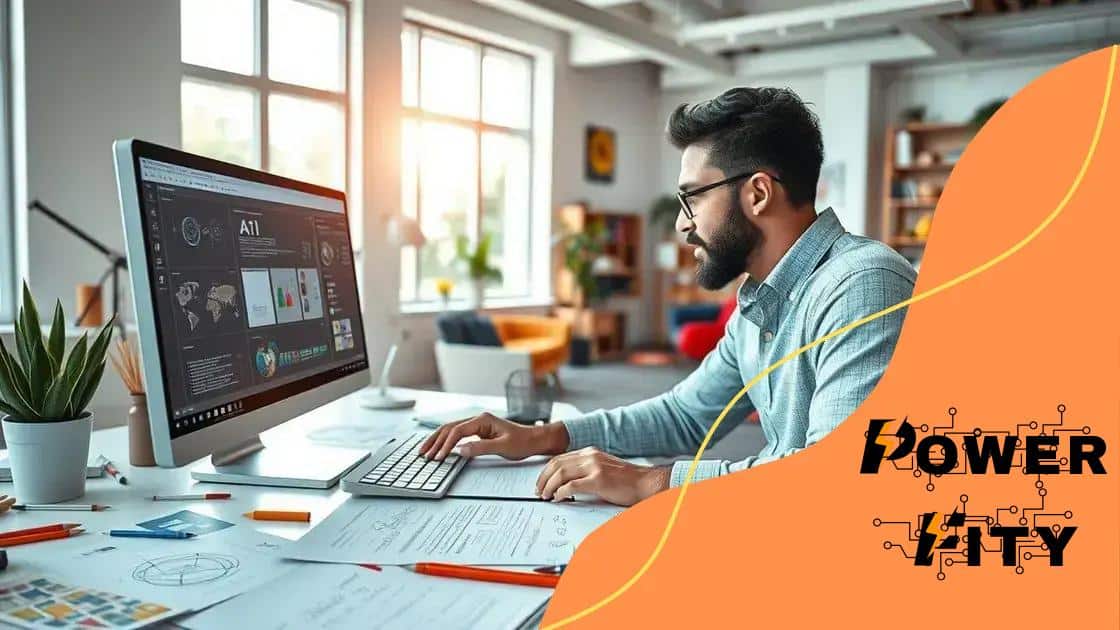The role of AI in transforming the creative industries

The role of AI in transforming the creative industries includes enhancing artistic expression, automating mundane tasks, and enabling personalized experiences, thus revolutionizing the way art and design are created and consumed.
The role of AI in transforming the creative industries is not just a trend; it’s reshaping how we think about creativity. Ever wondered how machines are enhancing artistic expression?
Understanding AI’s impact on art creation
Understanding AI’s role in art creation is more vital than ever. As technology advances, artistic practices are evolving, leading to fascinating outcomes. Artists now explore AI-generated art, which combines traditional methods with innovative algorithms.
The collaboration between artists and algorithms
This partnership can produce unique pieces that reflect both human intuition and machine learning. Artists can use AI to generate inspiration, enhance their creativity, and even automate repetitive tasks.
- New creative possibilities emerge.
- Improved efficiency in the creative process.
- Expanding the definition of what art can be.
Additionally, AI tools assist artists in breaking down complex tasks. For instance, programs can offer suggestions for color palettes or composition, allowing creators to focus on their vision. Notably, the collaborative nature of this technology encourages experimentation.
Autonomous AI art generation
Furthermore, we see fully autonomous AI art generation. These systems can create completely new pieces without human intervention. This raises questions about authorship and originality. Can a machine be credited as an artist? The debate is ongoing.
As AI techniques progress, new art forms will likely emerge, challenging our understanding of creativity itself. Many artists view these tools as just another medium of expression, comparable to paint or digital software. The impact of AI on art creation is profound, shaping not only the art produced but also the very idea of what it means to be an artist in this modern age.
How AI tools enhance creative processes
AI tools play a significant role in enhancing creative processes across various fields. By integrating artificial intelligence into their workflows, creators can unlock new levels of productivity and innovation. Whether it’s graphic design, music production, or writing, AI makes the creative process more efficient and exciting.
Streamlining repetitive tasks
Many creative projects involve tasks that can be time-consuming and repetitive. AI can automate these processes, allowing artists to focus on their creative vision. Tasks like sorting through thousands of images or generating templates can be done faster and more effectively with AI support.
- Automated graphic design layouts.
- Ease of color matching in art.
- Efficient sound mixing in music.
This means that artists spend less time on mundane activities and more time bringing their ideas to life. The ability to quickly experiment with different styles and elements can lead to surprising and innovative results.
Enhancing creativity with suggestions
AI tools also offer recommendations that enhance creativity. For instance, in writing, AI can suggest phrases or structures that improve narrative flow. In visual arts, it might provide color schemes or composition ideas based on existing works. These suggestions encourage artists to experiment and explore new directions.
Moreover, AI can analyze trends and audience preferences, providing creators with insights on what resonates with their audience. This valuable feedback helps in refining their work and achieving better engagement.
As the technology continues to advance, AI tools will become even more integrated into creative processes. This will transform how we think about creativity, making it a blend of human inspiration and machine intelligence, pushing the boundaries of what is artistically possible.
The benefits and challenges of AI in design

The benefits and challenges of AI in design are critical topics to explore. As technology advances, AI tools offer designers innovative solutions while also presenting unique obstacles. Understanding these dynamics can help creatives navigate the evolving landscape.
Benefits of AI in design
One of the most significant advantages of using AI is the ability to enhance productivity. Tasks that typically consume a lot of time, such as layout adjustments or color matching, can be automated. This allows designers to focus on creative aspects. For example, AI algorithms can analyze trends and suggest designs that are more likely to resonate with the target audience.
- Faster turnaround times for design projects.
- Ability to analyze user data for insights.
- Enhanced creativity through inspiration tools.
Moreover, AI can assist in personalizing user experiences. By understanding preferences, AI can help create designs that align closely with individual user needs, leading to more effective communication through visuals.
Challenges of AI in design
Despite its potential, the integration of AI in design is not without challenges. One major concern is the risk of losing the human touch in creativity. While machines can generate designs, they may lack emotional depth and context that only a human designer understands. Additionally, reliance on AI tools might lead to a homogenization of design styles, where unique personal touches might be lost.
Another obstacle is the learning curve associated with new technologies. Many designers may feel overwhelmed by the complexity of AI tools and how to incorporate them effectively into their workflows. It’s important to ensure that training and support are available for those looking to integrate AI into their practices.
As designers continue to explore the realm of AI, balancing these benefits and challenges will be crucial. By embracing the positives while being mindful of the potential pitfalls, creatives can leverage AI to push the boundaries of their work and achieve innovative results.
Case studies: Successful AI applications in the arts
Case studies of successful AI applications in the arts illustrate the powerful combination of technology and creativity. These examples highlight how artificial intelligence not only enhances artistic expression but also opens up new avenues for artists and designers.
AI in music composition
One notable case is the use of AI in music composition. Programs like OpenAI’s MuseNet can create original music across various genres. Musicians have begun using these AI tools to generate melodies and harmonies, leading to innovative collaborations. With AI, composers can explore new musical ideas and push beyond traditional boundaries.
- Creating complex arrangements quickly.
- Assisting in the songwriting process.
- Exploring new genres effortlessly.
By leveraging AI in music, artists can enhance their creative process, allowing for a richer exploration of sound.
Visual arts and AI technology
Another exciting application is in visual arts. Artists like Refik Anadol use AI to generate immersive installations that blend data with artistic visuals. These works often transform large datasets into stunning visual representations. The AI analyzes patterns and trends, creating dynamic pieces that engage audiences in new ways.
This integration of data-driven art opens discussions about the relationship between technology and creativity. The results are often mesmerizing, pushing viewers to consider the impact of data on artistic expression.
Moreover, AI tools like DALL-E create images from text prompts, allowing artists to visualize concepts in unique ways. This encourages experimentation and creativity, as artists can generate and iterate on ideas rapidly. Such AI applications are revolutionizing how art is produced and consumed.
Overall, these case studies offer a glimpse into the future of the arts, showcasing how AI can amplify creativity while challenging traditional notions of artistic authorship.
Future trends: What’s next for AI in creativity?
Future trends in AI for creativity indicate a rapidly evolving landscape. As technology advances, artificial intelligence is set to play an even bigger role in the creative industries. This section explores what lies ahead for artists, designers, and creators.
Personalized creative experiences
One significant trend is the rise of personalized creative experiences. AI will analyze individual preferences and behaviors, enabling tailored content creation. This means that art, music, and literature can be customized to resonate deeply with audiences.
- AI-generated recommendations for art styles.
- Music playlists based on user moods.
- Interactive storytelling that adapts to choices.
Such personalization can enhance engagement and foster a stronger connection between creators and their audiences.
Collaborations between humans and AI
In the future, we can expect more collaborations between humans and AI in the creative process. AI will serve as a creative partner, offering insights and suggestions while allowing artists to maintain their unique voices. This collaboration will lead to groundbreaking art forms that blend technological innovation with human creativity.
Moreover, as artists embrace AI, new tools will emerge to make the creative process even more seamless. Enhanced user interfaces will make it easier for artists to visualize their ideas and experiment with different concepts in real-time.
As communities grow around AI-generated art and creative tools, sharing knowledge and techniques will drive innovation. Workshops, online courses, and collaborative projects will become more common, enabling both beginners and experts to learn from one another.
In summary, the future of AI in creativity promises to be dynamic and exciting. By leveraging technology, artists will unlock new possibilities for expression while redefining what it means to create in a digital age.
FAQ – Frequently Asked Questions about AI in the Creative Industries
How does AI enhance artistic creativity?
AI provides tools that offer inspiration, generate ideas, and automate repetitive tasks, allowing artists to focus on their creative vision.
What are the benefits of using AI in design?
AI enhances productivity, offers personalized experiences, and helps streamline the design process by automating routine tasks.
What challenges do artists face when using AI?
Artists may struggle with the loss of the human touch in creativity and face difficulties in learning to use new AI tools effectively.
What future trends can we expect in AI and creativity?
The future will likely see more personalized creative experiences and deeper collaborations between humans and AI, leading to innovative forms of expression.





